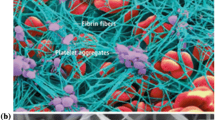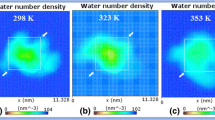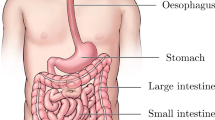Summary
Artificial clots made from fibrin glue with and without an inhibitor of fibrinolysis can be used to treat gastrointestinal bleeding. We have been unable to find descriptions of the effects of acid and pepsin upon such artificial clots. Therefore, 10−2 mol/l epsilon aminocaproic acid was added to fibrin glue in vitro at acid concentrations of pH 1.0 and pH 5.5. Pepsin was added at 9000 U/50 ml, the expected value for fasting human subjects. There was a highly significant reduction in clot survival at pH 1.0. At pH 5.5, clot weight was also significantly decreased with pepsin, compared to control. Thus pepsin and acidity greatly affect survival of artificial clots, but the addition of epsilon aminocaproic acid did not affect clot survival.
Similar content being viewed by others
References
Albrecht F, Roessner A, Zimmermann E (1983) Closure of osteochondral lesions using chondral fragments and fibrin adhesive. Arch Orthop Trauma Surg 101: 213–217
Baker JW, Spotnitz WD, Nolan SP (1987) A technique for spray application of fibrin glue during cardiac operations. Ann Thorac Surg 43: 564–565
Binder HJ, Donaldson RM (1978) Effect of cimetidine on intrinsic factor and pepsin secretion in man. Gastroenterology 74: 371–375
Brooks AM, Isenberg J, Grossman MI (1969) The effect of secretin, glucagon, and duodenal acidification on pepsin secretion in man. Gastroenterology 57: 159–162
Collen D (1980) Natural inhibitors of fibrinolysis. J Clin Pathol 33 [Suppl 14]: 24–30
Diem K, Lentner C (1973) Geigy scientific tables, 7th edn. Ciba-Geigy, New York, pp 407, 650
Gillespie IE, Bowen DJ (1962) Gastric secretion of pepsin in man. Gut 3: 255–259
Glover W, Chavis TV, Daniel TM, Kron IL, Spotnitz WD (1987) Fibrin glue application via the flexible fiberoptic bronchoscope: closure of bronchopleural fistulas. J Thorac Cardiovasc Surg 93: 470–472
Harting F, Koornneef L, Peeters HJ, Gillissen JP (1985) Glued fixation of split-skin graft to the bony orbit following exenteration. Plast Reconstr Surg 76: 633–635
Hjortrup A, Nordkild P, Kiaergaard K, Sjontoft E, Olesen HP (1986) Fibrin adhesive versus sutured anastomosis: a comparative intra-individual study on the small intestine of pigs. Br J Surg 73: 760–761
Jakob H, Campbell CD, Stemberger A, Wriedt-Lubbe I, Blumel G, Replogle RL (1984) Combined application of heterologous collagen and fibrin sealant for liver injuries. J Surg Res 36: 571–577
Kram HB, Garces MA, Klein SR, Shoemaker MD (1985) Common bile duct anastomosis using fibrin glue. Arch Surg 120: 1250–1256
Lattallo ZS, Teisseyre E, Ardelt W, Wegrzynowica A, Kopec M (1978) Fibrino(geno)lysis by enzymes other than plasmin. In: Gaffney PJ (ed) Fibrinolysis: current fundamental and clinical concepts. Academic Press, London New York, pp 129–136
Linscheer WG, Fazio TC (1979) Control of upper gastrointestinal hemorrhage by endoscopic spraying of clotting factors. Gastroenterology 77: 642–646
Linscheer WG, Fazio TC (1982) A controlled study on the effectiveness of endoscopic spraying of clotting factors on upper gastrointestinal (UGI) bleeding sites. Gastrointest Endosc 28: 137
Matras H (1985) Fibrin seal: the state of the art. J Oral Maxillofac Surg 43: 605–611
McCarthy PM, Frazee RC, Hughes RW, Beart RW (1987) Barium-impregnated fibrin glue: application to a bleeding duodenal sinus. Mayo Clin Proc 62: 317–319
Nilsson IM, Bergentz S, Wiklander O, Hedner U (1975) Erosive hemorrhagic gastroduodentitis with fibrinolysis and low factor XIII. Ann Surg 182: 677–682
Poller L (1980) Fibrinolysis and gastrointestinal haemorrhage. J Clin Pathol 33 [Suppl 14]: 63–67
Prentice CRM (1980) Basis of antifibrinolytic therapy. J Clin Pathol 33 [Suppl 14]: 35–40
Scheele J, Gentsch HH, Matteson E (1984) Splenic repair by fibrin tissue adhesive and collagen fleece. Surgery 95: 6–13
Siedentop KH, Harris DM, Ham K, Sanchez B (1986) Extended experimental and preliminary surgical findings with autologous fibrin tissue adhesive made from patient's own blood. Laryngoscope 96: 1062–1064
Smith JL, Gamal MA, Chremos AN, Graham DY (1985) Famotidine, a new H2 receptor antagonist: effect on parietal, non-parietal, and pepsin secretion in man. Dig Dis Sci 30: 308–312
Spotnitz WD, Mintz PD, Avery N, Bithell TC, Kaul S, Nolan SP (1987) Fibrin glue from stored human plasma: an inexpensive and efficient method for local blood bank preparation. Am Surg 53: 460–462
Stemberger A, Blumel G (1982) Fibrinogen-fibrin conversion and inhibition of fibrinolysis. J Thorac Cardiovasc Surg 30: 209–214
Stenberg B, Risberg B, Hedman L, Peterson H (1981) Tissue fibrinolysis in experimental gastric ulcer: a study in the rat. Eur J Clin Invest 11: 361–367
Author information
Authors and Affiliations
Rights and permissions
About this article
Cite this article
Valenzuela, G.A., Spotnitz, W.D. & Stone, D.D. Pepsin fibrinolysis of artificial clots made from fibrinogen concentrate and bovine thrombin: the effect of pH and epsilon aminocaproic acid. Surg Endosc 3, 148–151 (1989). https://doi.org/10.1007/BF00591361
Issue Date:
DOI: https://doi.org/10.1007/BF00591361




